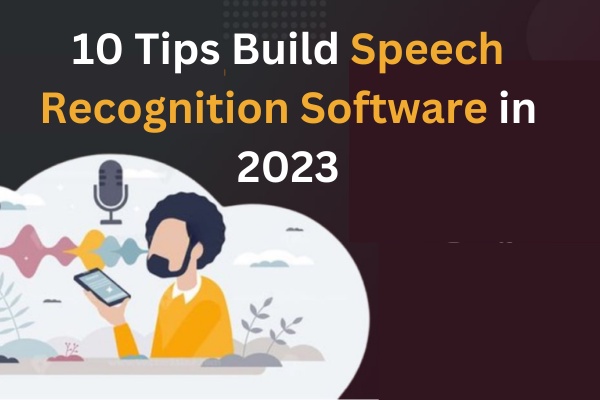Welcome to my blog on 10 tips to build speech recognition software in 2023! With the advancement of technology, speech recognition software has become an essential tool in many industries. From virtual assistants to call center automation, speech recognition software is revolutionizing how we interact with machines.
However, building speech recognition software can be daunting, especially for those new to the field. This blog will provide 10 valuable tips to help you build speech recognition software in 2023. These tips cover various topics, including data collection, model training, and evaluation, to help you create accurate and robust speech recognition software.
Whether you're a seasoned developer or a beginner, this blog will provide practical insights and strategies to help you build a cutting-edge speech recognition system. So, let's get started!
What is Speech Recognition Software

Speech recognition software, also known as speech-to-text software, uses advanced algorithms and machine learning techniques to convert spoken language into text format. It enables users to dictate text and control their computer using their voice rather than typing or using a mouse.
Speech recognition software can be used for various applications, including dictation, transcription, voice search, and voice commands for controlling devices and software. It is often used by people with disabilities or those who prefer hands-free computing.
Speech recognition software analyzes the audio input and compares it to a database of known words and phrases. The software then uses various algorithms to determine the most likely interpretation of the spoken words and converts them into text. The accuracy of speech recognition software has improved significantly in recent years, and it can now achieve near-human levels of accuracy in many cases.
10 Tips Build Speech Recognition Software in 2023
Speech recognition software has come a long way in the past decade. With the advancements in natural language processing (NLP) and machine learning (ML) algorithms, speech recognition software has become more accurate and reliable. If you're planning to build speech recognition software in 2023, here are ten tips to keep in mind:
Define your use case:
The first step is to define the use case for your speech recognition software. Will it be used for dictation, transcription, voice commands, or something else? A clear use case will help you design your software to meet user needs.
Choose the right algorithm:
There are many algorithms for speech recognition, such as Hidden Markov Models (HMM), Deep Neural Networks (DNN), and Recurrent Neural Networks (RNN). Choose the one that best fits your use case and has a proven track record of accuracy with the help of a software development company.
Collect and preprocess data:
You'll need a large dataset of audio files and their transcriptions to train your speech recognition software. You'll also need to preprocess the data by removing noise, normalizing the audio, and segmenting the audio files into smaller chunks.
Train your model:
Use your preprocessed data to train your speech recognition model. To achieve the
highest accuracy, you must experiment with different hyperparameters and training techniques.
Use transfer learning:
Transfer learning is a powerful technique that allows you to use pre-trained models to improve the accuracy of your speech recognition software. For example, you can use a pre-trained English speech recognition model and fine-tune it for a different language.
Use a language model:
A language model helps your speech recognition software understand the context of the spoken words. Incorporating a language model into your software can improve its accuracy and reduce errors.
Consider latency:
Latency is the time your speech recognition software takes to process the audio and return a result. Consider the latency requirements for your use case and optimize your mobile app development to meet those requirements.
Optimize for noise:
Noise is one of the biggest challenges in speech recognition. Your software should be able to handle different types of noise, such as background noise, microphone noise, and speaker noise. Use noise reduction and feature normalization techniques to improve accuracy in noisy environments.
Test, test, test:
Testing is critical to the success of your speech recognition software. Test your software with different accents, languages, and audio qualities to ensure it performs well in real-world scenarios.
Use feedback to improve:
Incorporate feedback from users to improve the accuracy and usability of your speech recognition software. Use analytics and user testing to identify areas for improvement and prioritize new features.
Benefits of Speech Recognition Software
Speech recognition software is a technology that enables computers to understand spoken words and phrases and convert them into text or commands. The benefits of using speech recognition software include the following:
Improved Productivity:
Speech recognition software can help users save time by allowing them to dictate documents, emails, and other forms of communication faster than typing.
Increased Accessibility:
Speech recognition software can benefit individuals with disabilities or mobility impairments, allowing them to use computers and other devices without needing a keyboard or mouse.
Reduced Strain:
Typing for extended periods can lead to repetitive strain injuries. Speech recognition software can help alleviate strain on the hands and wrists.
Improved Accuracy:
Advanced speech recognition software can achieve high levels of accuracy in transcribing spoken words, reducing the need for manual editing.
Multi-tasking:
Users can easily switch between tasks while dictating, such as responding to emails, researching, or filling in forms.
Customization:
Speech recognition software can be customized to the user's voice and speaking style, improving recognition accuracy.
Increased Efficiency:
With speech recognition software, users can complete tasks more efficiently, allowing them to focus on other work or leisure activities.
Overall, speech recognition software can offer numerous benefits to individuals and organizations seeking to improve productivity, accessibility, accuracy, and reduce physical strain.
Takeaway!
In conclusion, hiring an on-demand app development company and building speech recognition software requires signal processing, machine learning, and software development expertise. The basic steps include collecting and preparing the data, Extracting features from the audio signal, Building acoustic and language models, and performing speech recognition.
There are many challenges in building speech recognition software. Still, with the right techniques and algorithms, it is possible to build a system that can accurately recognize speech in various languages and environments.


No comments yet